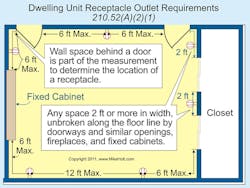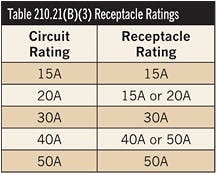All questions and answers are based on the 2011 NEC.
Q. What are the NEC requirements for sizing receptacles?
A. A single receptacle on an individual branch circuit must have an ampacity not less than the rating of the overcurrent device [210.21(B)(1)]. Note: A single receptacle has only one contact device on its yoke [Art. 100]; this means a duplex receptacle is considered two receptacles.
According to 210.21(B)(3), if the receptacle is connected to a branch circuit that supplies two or more receptacles, the receptacles must have an ampere rating in accordance with the values listed in Table 210.21(B)(3), as shown at the right.
Q. What are the Code requirements for placing receptacles on “wall space” in dwelling units?
A. A receptacle outlet must be installed in every kitchen, family room, dining room, living room, sunroom, parlor, library, den, bedroom, recreation room, and similar room or area in accordance with (1), (2), and (3) [210.52(A)]. A receptacle outlet must be installed so that no point along the floor line of any wall is more than 6 ft, measured horizontally along the floor line, from a receptacle outlet [210.52(A)(1)]. The aim of this rule is to ensure that a general-purpose receptacle is conveniently located to reduce the chance that an extension cord will be used.
Definition of wall space [210.52(A)(2)]:
- Any space 2 ft or more in width, unbroken along the floor line by doorways and similar openings, fireplaces, and fixed cabinets, as shown in the Figure above.
- The space occupied by fixed panels in exterior walls.
- The space occupied by fixed room dividers, such as freestanding bar-type counters or guard rails.
A new requirement added in 210.52(A)(4) specifies that receptacles installed for countertop surfaces, as required by 210.52(C), can’t be used to meet the receptacle requirements for wall space as required by 210.52(A).
Q. What is the Code rule regarding wiring under roof decking?
A. Cables, raceways, and enclosures under metal-corrugated sheet roof decking must not be located within 1½ in. of the roof decking, measured from the lowest surface of the roof decking to the top of the cable, raceway, or box. In addition, cables, raceways, and enclosures aren’t permitted in concealed locations of metal-corrugated sheet decking type roofing [300.4(E2)]. Note: Roof decking material will be installed or replaced after the initial raceway or cabling, which may be penetrated by the screws or other mechanical devices designed to provide “hold down” strength of the waterproof membrane or roof insulating material.
Exception: Spacing from roof decking doesn’t apply to rigid metal conduit and intermediate metal conduit.
About the Author

Mike Holt
Mike Holt is the owner of Mike Holt Enterprises (www.MikeHolt.com), one of the largest electrical publishers in the United States. He earned a master's degree in the Business Administration Program (MBA) from the University of Miami. He earned his reputation as a National Electrical Code (NEC) expert by working his way up through the electrical trade. Formally a construction editor for two different trade publications, Mike started his career as an apprentice electrician and eventually became a master electrician, an electrical inspector, a contractor, and an educator. Mike has taught more than 1,000 classes on 30 different electrical-related subjects — ranging from alarm installations to exam preparation and voltage drop calculations. He continues to produce seminars, videos, books, and online training for the trade as well as contribute monthly Code content to EC&M magazine.


